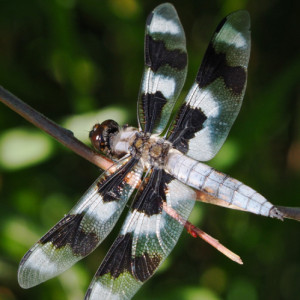Dragonfly Dreaming
Above his first home,
he revels -- reborn, airborne --
in speed, light, and love.
Have you found the dragonfly in this photo?
I don't know if it's the same one seen in my extra photo, a male Eight-spot Skimmer dragonfly, recently emerged from his larval skin. The pale, powdery bloom on his body, called pruinosity, will wear off during mating, leaving darker areas.
Skimmers live in still water, like Lake Padden, where I took both photographs. I was delighted to get so close to the Skimmer and love all the details visible in the photo, but my heart was drawn to the larger view, which reminded me of Impressionist art.
I knew very little about dragonflies before photographing the obliging Skimmer, who rested on that twig for several minutes, and I'm now fascinated by them! Here are some of the interesting facts I learned, mostly gleaned from Wikipedia:
* Dragonflies are found on every continent except Antarctica. They can fly in six directions: upward, downward, forward, back, to the left, and to the right.
* Dragonflies are predators in both their initial aquatic larval stage -- which can be as long as five years and during which they are known as nymphs or naiads -- and as adults.
* When the nymph is ready to metamorphose into an adult, it stops feeding and makes its way to the water surface. It remains stationary, with its head out of water, while its respiratory system adapts to breathing air, and then climbs a reed or similar plant, and molts.
*After attaching itself firmly in a vertical position with its claws, its skin begins to split at a weak spot behind its head. The adult dragonfly crawls out of its larval skin, arching backwards when all but the tip of its abdomen is free, allowing its exoskeleton to harden.
* Curling backwards and upwards, it completes its emergence, swallowing air, which plumps out its body, and pumping hemolymph (a fluid found in arthropods that's analogous to the blood in vertebrates) into its wings, which causes them to expand to their full extent.
If you've read this far and are interested in learning more about dragonflies, this website has fantastic photos and the British Dragonfly Society website offers lots of information.
Blip 1315


Comments
Sign in or get an account to comment.


